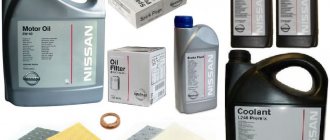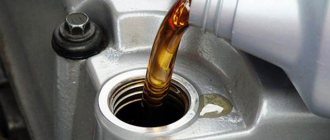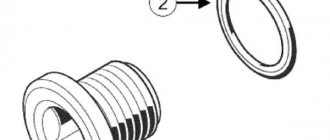Some nuances
The main cause of automatic transmission breakdowns is associated with operating the vehicle with low oil levels. And this, in turn, is a consequence of rare checks or an incorrect algorithm of actions. Therefore, every owner of a car with an automatic transmission needs to know how to properly check the condition of the oil in the box.
There are two types of automatic transmissions:
- with probe;
- with a stopper.
In most modern cars, checking the oil level in the automatic transmission is done in the same way as in the engine. Those. using a probe. Its location under the hood depends on the type of drive:
- on front-wheel drive vehicles, it is most often located on the left side;
- on rear-wheel drive cars - it is located behind the engine.
However, on some brands, for example on most Mercedes or Audis, there is no dipstick. Therefore, checking the oil in the automatic transmission yourself will be difficult. The car will have to be driven onto an overpass or lift. And then take out the plug to control the level. In principle, the same procedure is required as for checking cars with manual transmission, where the dipstick is missing.
Safety rules when checking fuel and lubricants
The first thing you need to become familiar with when performing any operation on a machine is the safety rules. Neglecting them is a direct path to injury.
When checking the amount of lubricant and replacing it, remember:
- The motor warms up before operation and remains on during operation, so you can get burned by oily liquid.
- Even a cold product has a bad effect on the skin, leading to irritation or chemical burns, depending on its composition.
- Engine parts are hot.
You need to work with gloves. This simple rule will save you from the unpleasant consequences of coming into contact with hot metal and accidentally spilling liquid on your hands. Of course, protection made from fire-resistant materials is inconvenient - it’s unlikely that anyone would put it on just to check the oil level in the box. If you act carefully, simply use rubberized products.
Oil check
Before checking the oil in the automatic transmission, the car needs to be warmed up. Sometimes you can find recommendations that say that the lubricating fluid will return to normal if you make several shifts of the gearbox selector. However, it is not. To correctly determine the level, the oil must be heated to operating temperature. And for this you will have to travel 10-15 km.
When the box warms up, you need to stand on a flat surface and move the selector to the “P” position, if it is, for example, a Toyota. Now you can check the oil level in the gearbox without stopping the engine.
Depending on the model, the marks on the test dipstick may differ. Usually, they have two meanings, such as for Solaris:
- cold – minimum and maximum for checking the cold level;
- hot – the same thing, but for a warm engine.
However, this does not always happen. There may be only two marks, or, like the Civic, one that allows you to measure the fluid in a cold state.
In addition, there is other useful information on the dipstick. The brand of transmission oil and the position in which the automatic transmission selector should be during measurement may be written on it.
You should know that o determines how much oil is poured into the box when replacing it. In the case of a scheduled level check, it can only be used as an additional indicator.
Oil change steps
In Toyotas, replacing the lubricant in the gearbox is divided into 3 types:
- Interim replacement. It is performed in order to remove the old product and then add new transmission fluid.
- Standard replacement. It is performed when the time for filling a new lubricant is approaching.
- Full download. It is called continuous downloading.
When carrying out work to change the oil in the gearbox, it is necessary to unscrew the drain plug and wait until the oil drains completely.
An intermediate oil change in an automatic transmission is carried out in several stages. First, the old lubricant is carefully drained, after which new fluid is added to the automatic transmission. It is necessary to remove and thoroughly wash the box tray and filter. After you complete the fluid replacement process, the automatic transmission pan and filter are mounted back.
This method repeats the process of changing the oil in a Toyota manual transmission. Intermediate replacement should be performed every 20-30 thousand km.
This system has several disadvantages. Firstly, half of the old grease remains inside the box. Secondly, even if you regularly fill in new oil, the share of old oil will still be significant.
A standard lubricant change is more difficult to complete. First, the old grease is removed; this is very easy to do through a special drain hole. Then you should remove the pan from the box, the old filter should be removed. After the procedure is completed, install a new filter, put the pan back, and pour new oil into the automatic transmission.
The full injection method differs from others in that the driver will need special tools to change the oil in the automatic transmission. Connect them to the automatic transmission by connecting them to the lubricant supply system. Oil is pumped under pressure. First, the old fluid is pumped out of the automatic transmission, then new oil is poured into it.
This is the most effective method that allows you to completely remove old lubricant from an automatic transmission. It should be noted that there is no accumulation of old product on the inside of the box.
The oil filter also needs to be changed when fully pumped; this is done at the very end of the procedure.
How to measure the oil level
How to check the oil in an automatic transmission:
- first, you need to find out whether you need to turn off the car engine. On most brands, the engine must be running, but for example, on Hondas, it must be turned off before checking;
- secondly, determine the desired position of the selector. As a rule, this is "R". But, for example, on Mitsubishi transmissions, the automatic transmission is moved to the “N” position;
- now, you need to find the dipstick itself, it is usually red and make sure that there is no dirt near it;
- the dipstick is removed from the box and wiped;
- The clean dipstick goes back down for a few seconds and comes out again. Now you can see how much oil is in the box.
Under normal conditions, the level should be between the minimum and maximum of the hot mark.
In addition to the level, you need to pay attention to visual characteristics:
- the lubricating fluid should be transparent, without a burning smell;
- there should be no plaque on the dipstick.
If the ATF is clearly not in order, this is a serious reason to immediately contact a car service center. Otherwise, unpleasant consequences may arise in the form of expensive automatic transmission repairs.
By the way, an important point is that all transmission fluids differ in color and smell. Therefore, when the time comes to change the automatic transmission oil, it is advisable to remember these indicators - this will make it easier to monitor its condition when checking.
If the results are in doubt, especially when the oil on the dipstick is dirty, it is worth taking a control measurement. To do this, dry the blade well and lower it into the box again. It happens that old dirt just stuck to it.
Another important point. If the oil level in the box is high or low, it will foam. Visually this can be seen very well - the probe blade will be covered with uniform foam. By the way, single large bulbs are not a reason to worry. They could occur while immersing or removing the blade from the lubricant.
How to check the oil level in an automatic transmission
Before checking the oil level, the automatic transmission is heated to 65 degrees Celsius. It is better to do this by driving a car for 10–15 km. But if this is not possible, start the engine and let it run until the fan turns on or until the coolant temperature reaches 90–95 degrees.
The box is switched to parking mode or neutral (on some automatic transmissions). The method of measuring the oil level depends on the machine model. Most boxes have a dipstick, but there are some that do not have one. Check the fluid with the engine running.
Automatic transmission with dipstick
There are two marks visible on the dipstick (Cold) and (Hot). The first shows the cold oil level. The second mark indicates the level of hot liquid in the box and is a more accurate meter. It is checked in several stages:
- Warm up the box
- Place the machine on a level surface
- Place the automatic transmission lever in park mode (P) with the engine running
- Remove the dipstick from the box
For an accurate measurement, lower the probe into the box several times at large intervals. The oil level has reached the Hot mark zone and is considered normal. If a trace of transmission fluid is between the marks, this indicates a low level. In this case, add more oil to prevent foaming.
Automatic transmission without dipstick
Not all automatic transmission models have a dipstick. Such automatic transmissions are designed for servicing in special service centers. Automatic machines without a dipstick have two holes: for filling oil and draining. How to determine the fluid level? A special oil quantity limiter is screwed into the drain plug hole. It looks like a long tube and works on the following principle: excess liquid is drained into the pan above. Thus, the level is determined by the height of the limiter.
Automatic transmissions with such a system are not at risk of oil overflow. Excess liquid is drained through the unscrewed plug. The disadvantage of these automatic transmissions is that it is inconvenient to check the transmission fluid level. It is difficult to determine the degree of oil contamination. It is better for an inexperienced car owner to go to a service station. But if you are confident in your abilities and are ready to learn how to service a car yourself, then you can try.
To check the oil, follow these steps:
- Warm up the automatic transmission to operating temperature
- Place the car on a flat surface above the hole or use a lift
- Place the automatic transmission lever in park mode (P). The engine must be running all the time
- Unscrew the drain plug of the pan
A small amount of excess liquid will flow out. If nothing even drips, the level is below normal. To fix this, add oil through the filler hole in the box. Filling is carried out with the engine running. You will see excess transmission fluid flowing out of the drain hole. Wait for the drops to start flowing and tighten the hole. In this simple way, the required oil level is set. Experts advise changing old fluid, which may contain contaminants.
If the automatic transmission is not serviced on time, this will lead to expensive repairs. How? You overlooked the oil level. A lack of fluid or an excess will shorten the service life of the machine or cause it to fail unexpectedly.
Why can't you slip on an automatic transmission?
What do deviations from the norm lead to?
Regardless of whether the level is above the norm or below, this is fraught with trouble for the box. And until it is brought back to normal, you cannot drive the car.
If below:
- the overall pressure of the system will decrease because the pump will suck in air. As a result, wear of all mechanisms increases, gears may disappear, the box overheats;
- The most important thing is that the automatic transmission can fail very quickly.
If higher:
- first, the butter will foam. And this will worsen the level of lubrication of parts and lead to overheating of the box;
- in principle, the consequences will be the same as with a reduced one.
It is possible to determine that there is a high oil level in an automatic transmission by indirect signs - an excess of lubricating fluid will leak from it. Therefore, while parking, oil stains may appear under the car.
By the way, the amount of lubricant in the box may also seem too high when foaming. That is, for example, the level is below normal, but due to foaming, it increased in volume, and the test result showed a high level. In this case, to determine how much oil is actually in the box, you need to let the car cool down. And after that, take measurements when cold. The ambient temperature must be above 0.










